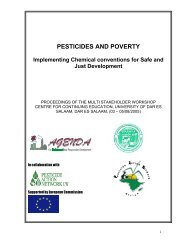Your Daily Poison - Pesticide Action Network UK
Your Daily Poison - Pesticide Action Network UK
Your Daily Poison - Pesticide Action Network UK
You also want an ePaper? Increase the reach of your titles
YUMPU automatically turns print PDFs into web optimized ePapers that Google loves.
environment in the cycle of precipitation and<br />
evaporation.<br />
Private water supplies<br />
There are about 42,000 private water supplies<br />
in England and 8,000 in Wales, ranging from<br />
those supplying a single property to much<br />
larger supplies. Although there are some in<br />
urban areas, they are mostly in more remote<br />
rural parts of the country. The source of the<br />
supply may be a well, a borehole, a spring, a<br />
lake or a stream 32 . Local authorities have the<br />
responsibility for testing for pesticides in private<br />
water supplies, see table.<br />
Only four local authorities disclosed how many<br />
pesticides they test for in private water<br />
supplies:<br />
North Herefordshire District Council 29<br />
Perth & Kinross Council 25<br />
Penwith District Council 19<br />
Sevenoaks District Council 28<br />
The data on which companies and local<br />
authorities base judgements about usage of<br />
Table 5. <strong>Pesticide</strong>s in private drinking water supplies.<br />
Summary of PAN <strong>UK</strong> survey – Appendix 6c, page 42<br />
PAN <strong>UK</strong> Questionnaires sent Approx 468 local authorities in England,<br />
to: Wales, Scotland and Northern Ireland<br />
Number of responses received In 2004 (2002 data) In 2005 (2004<br />
(from local authorities with data)<br />
private water supplies): 37 20, 17 of which are<br />
from new<br />
respondents<br />
Number range of private 1 to 1780 (average 0 to 1153 (average<br />
water supplies for which 206) 177)<br />
local authority responsible<br />
for testing<br />
Number range of private 1992 to 2002: In 2003-2004:<br />
water supplies tested by 0 to 76 0 to 16<br />
local authority respondents<br />
Number range of pesticides 0 to 89 19 to 29<br />
reported by local authority<br />
respondents as tested for<br />
Number of local authority 8 Not answered.<br />
respondents reporting that<br />
100 per cent of the pesticides<br />
they tested for were detected<br />
in all tests above limit of<br />
detection<br />
Number of local authority 3 0<br />
respondents reporting<br />
exceedances of legal limit<br />
(0.1 micrograms per litre)<br />
pesticides on horticultural and most arable<br />
crops in their catchment areas is the limited<br />
sample survey carried out by the Central<br />
Science Laboratory’s <strong>Pesticide</strong> Usage Survey<br />
Group 33 , which can be analysed to produce<br />
locally-relevant data. Some specialist<br />
companies produce data on pesticides used on<br />
arable crops on a regional basis.<br />
Conclusions<br />
Data gathered in PAN <strong>UK</strong> surveys indicate that<br />
pesticides are present in water at low levels.<br />
Looking in detail at both the public and private<br />
water supply, the presence of pesticides is<br />
confirmed in both raw (untreated), and drinking<br />
water, at levels which are below the legal limit,<br />
but above the limit of detection. As the EC<br />
threshold was intended to achieve zero<br />
pesticides in drinking water on a precautionary<br />
basis 34 , our evidence indicates the need to<br />
lower the limit. Proper protocols for testing are<br />
needed; and mandatory pesticide usage<br />
reporting should be implemented to provide a<br />
reliable source of information for water<br />
companies and local authorities.<br />
the second <strong>UK</strong> pesticide exposure report 13

















